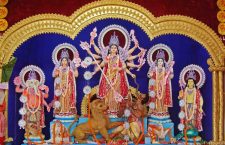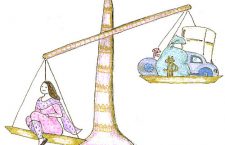Bhool Hone Par Turant Kshama Maange
At first this dictum of a message, painted in no-nonsense black, minus its English translation (‘Upon realizing your mistake, apologize immediately’) on the walls of the classroom in the primary school of Khandeha village, located in Bargadh, Mau block, in the Chitrakoot district of Bundelkhand, Uttar Pradesh, seems ironic. Or even tongue-in-cheek. After all, the school has been declared ‘English Medium’ just a few months ago, but in the last almost-five months now, there hasn’t been much to show for it. Not even a sign, quite literally. But for the name of the school that was hurriedly re-painted a few weeks ago.
But the school has other graver problems. The student teacher ratio being one. The students of Khandeha – all 155 of them – have one teacher who teaches them all the subjects. As
Akash, a young, local social worker puts it, “The school turned English medium in April. But there is only one teacher here.”
We meet this one warm body, whose name is Vinay Kumar, the head teacher (or rather only teacher) here at the school. It appears he is doing all he can to make the best of the situation. Forthcoming with the details of how he copes with the situation, he tells us how he usually gets the students of Classes IV & V to assemble together before handing them their assignments for the day. This enables him to move onto the other grades. “What can I do?”, says Kumar, quite simply, and very open to suggestions it seems, even from reporters such as ourselves. “I’m the only working teacher here to 155 students. At least 5 are needed, as per the guidelines.” Sadhna, a student at the school, confirms this strategy, “Yes, we generally keep studying on our own. Or we complete the assignment given to us.”
The Ministry of Education’s directive asking for a percentage of government-run primary schools to be turned into English-medium schools was part of the Sarva Shiksha Abhiyan programme. It was meant as a counter-move to correct the steady spike in drop-out rates from government schools, with parents and guardians in rural areas choosing to shift their wards to private schools. In tandem with the government’s orders, the Uttar Pradesh government declared 5,000 government primary schools “English-medium”, effective from the academic session of April 2018, and further promised to establish at least 5 such schools in every block of every district in accordance with the demand. The primary school in Khandeha village was one such school.
That this dramatic change has only caused more confusion in an education system already reeling in chaos, succumbing to daily pressures, arguably goes without saying. But the data is even more worrying, especially in the context of student-teacher ratios. According to the CAG report for 2015-2016, there has been a shortage of 1.75 lakh teachers in the state, as opposed to the required 7.6 lakh; while over 17,000 primary schools did not meet the prescribed pupil-teacher ratio.
The concern of under-qualified or unqualified teachers across government schools – the report pegs this number at 30,000 + – is also flagged by Indrajeet Singh, Assistant Co-ordinator, in the education department of Chitrakoot. Citing the basic problem as he sees it, which is also true of Khandeha, in his view, is the lack of English-speaking teachers. Says Singh, “Teachers are selected, on the district-level, for English medium schools. If there’s a lack in numbers, then we’ll conduct the exam again.” He’s quick to add the all-important caveat, “But if we don’t find anyone eligible, then we can’t hire.”
Meeting Ganesh, who’s leaving the Khandeha primary English medium school for the days, outside, marks a book-end to our report. When we ask him, in Hindi, if the English grammar and literature textbooks have arrived, he has a pat reply for us.
“No”, he says, with a hint of a smile on his face.
This Khabar Lahariya article first appeared on Firstpost. For a report on the Khandeha school turning English medium, click here.

